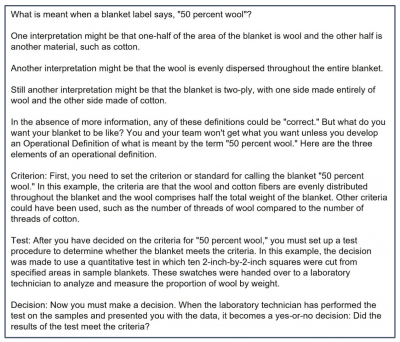
Key Points
- Operational definitions are defined depending on the parameters you assign.
- They provide a clear-cut method of working on something, allowing for universal understanding.
- Paying attention to operational definitions in the workplace opens up paths of communication with our employees and customers.
One of the biggest issues you may face with your customers is the lack of a good definition of what you think you are doing and how they define it. Operational definitions are the key to better communication within your organization and with those outside. Let’s examine what a good operational definition looks like and the benefits of having them.
Overview
If you were asked to count the number of blue shirts in a room full of people, would you agree with the person next to you, across from, or behind you? Probably not. If you go onto Amazon and search for “blue shirt,” you will see the following:

This is the essence of an operational definition. Everyone needs to agree on what they are talking about.
Operational definitions apply to many things you encounter every day. For example, all the measurement systems you use (feet/inches, weight, temperature) are based on common definitions. Sometimes these are called standards. This is critical when you’re doing an MSA, or measurement system analysis.
Other times, your operational definitions are less clear. For example, when you say an order is “delivered,” you may mean at the back door. Your customer may mean “checked in by receiving.” A third person might mean “the product is on the shelf.” In addition to operational definitions of measurement, the concept also applies to operationally defining a customer requirement, a procedure, a regulation, or anything else that benefits from a clear, unambiguous understanding.
Making Effective Operational Definitions
A good operational definition should:
- Be clear, specific, definable, measurable, and unambiguous
- Specify the device for measuring the factor
- Specify the units of measurement and time frame
- Describe the measurement method
- Include the decision criteria
A common term that’s often miscommunicated is turnaround time for an order. The following might be a good operational definition.
Turnaround time will be the time in hours (rounded up to the nearest whole hour) as measured by the clock on the wall in the sales office. It will be measured from when the customer service rep enters the complete customer’s order into the QuickOrder computer system until the time the order is received at the customer’s loading dock and checked into the customer’s system by the receiving clerk.
The above operational definition is for a measurement of continuous data where the characteristic was measured. You could apply the same concept when the characteristic needs to be defined in terms of discrete or attribute data.
In this case, you would be counting something rather than measuring it. An example would be if you were trying to create an operational definition for the number of scratches on a product. This is usually done using a visual display of what a scratch would look like. The measurement device could be a person who would be deciding whether they were looking at a scratch or not.
Benefits of an Operational Definition

Good communication between you and your customer is vital to eliminating debates and disagreements. The same holds for people communicating within your organization. The best question to ask is, “What do you mean by that?” This will lead you into a discussion of operational definitions.
Everyone Defines and Measures the Same Way
By having good, agreed-upon operational definitions, you will eliminate disputes and disagreements.
Confidence in Analytical Results
By knowing what you’re measuring and how you’re doing it, you will be more confident in your interpretation of the results from any data analysis you are performing.
Eliminates Bias and Opinions from Discussion
Famed statistician and quality guru Dr. W. Edwards Deming said, “Without data, you’re just another person with an opinion.” Operational definitions eliminate opinion and subjectivity and replace them with objective decisions about what and how you are measuring things.
Why It Matters
So, why does anyone use operational definitions in the workplace? Think about it for a moment, could you imagine the nightmare that would ensue if you gave the same task to multiple employees without explicit instructions? If you told three people to accomplish a task without a definition in place, you’d get three different results.
Why Are Operational Definitions Important to Understand?
Developing an operational definition is not a trivial task. You need to understand the importance of them as a tool for reducing confusion and miscommunication.
We Live in a Data-driven World
Businesses are relying more and more on data to help make business decisions. If people don’t understand what is being measured or how they won’t be able to understand what the data is telling them. This will hurt business decisions.
Any Characteristic Should Have an Operational Definition
Operational definitions are equally applicable to things you measure and things you count. You will want to recognize the difference and how to develop your operational definitions accordingly.
There Isn’t a Universal Definition
A key learning is there is no real universal definition of anything. If we agree that the sky is green and have defined it that way, then the sky is green. The purpose of an operational definition is to eliminate miscommunication between people. If everyone agrees on what and how things are defined and measured, then miscommunication disappears.
An Example of Operational Definitions
Presented below is a classic example used when teaching about operational definitions.

Image source: Operational Definition Example
Best Practices When Using Operational Definitions
Getting to an agreement on something that is operationally defined takes time and patience. Here are a few tips to help you come up with a good operational definition.
Be as Specific as You Can
The more specific and detailed you make your operational definition, the greater your chance of avoiding miscommunication.
Use Visualization
Words can convey different meanings. Where possible and appropriate, use a visual to define things along with the method of how you will measure and make a decision.
Test Your Operational Definition
The best way to test whether your operational definition makes sense is to run it by someone unfamiliar with the subject. If they understand what you mean, then your definition is probably stated clearly.
Other Useful Tools and Concepts
Operational definitions aren’t the only tools at your disposal when it comes to optimizing your business. Understanding the true definition of yield, for example, in the context of Lean Six Sigma is paramount to nail down. Our handy guide covers the true meaning in the context of the methodology.
Additionally, you might want to consider how Tollgate reviews impact your DMAIC approach. Process improvement can be fickle, but having the means to check progress and give reports on the status of a process is worth implementing.
Conclusion
An operational definition is a clearly defined description of some characteristic. It should be specific and describe not only what you are measuring but how. Your operational definition needs to be agreed upon by the other party, whether that’s your customer or an internal function of your organization. You want everyone to define, measure, and interpret things the same way.